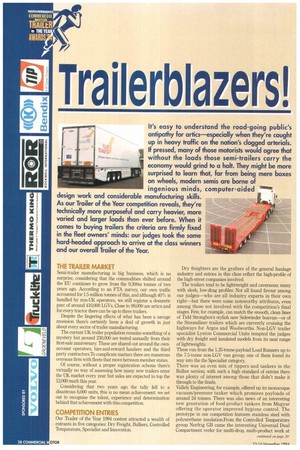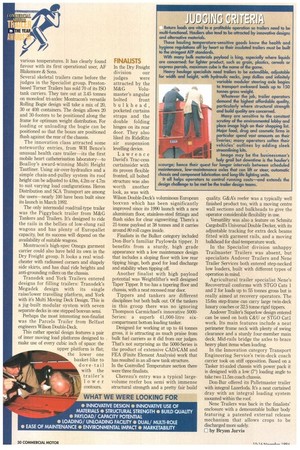Trallerblazers!
Page 30

Page 32

If you've noticed an error in this article please click here to report it so we can fix it.
THE TRAILER MARKET
Semi-trailer manufacturing is big business, which is no surprise, considering that the commodities shifted around the EU continues to grow from the 9,300m tonnes of two years ago. According to an FTA survey, our own traffic accounted for 1.5 million tonnes of this, and although 40% is handled by non-UK operators, we still register a domestic pare of around 410,000 LGVs. Close to 99,000 are artics and for every tractor there can be up to three trailers.
Despite the lingering effects of what has been a savage recession there's certainly been a deal of growth in just about every sector of trailer manufacturing.
The current UK trailer population remains something of a mystery but around 230,000 are tested annually from their first-sale anniversary These are shared out around the ownaccount operators, hire-and-reward hauliers and the third party contractorsTo complicate matters there are numerous overseas firm with fleets that move between member states.
Of course, without a proper registration scheme there's virtually no way of assessing how many new trailers enter the UK market every year but sales are expected to top the 12,000 mark this year.
Considering that two years ago the tally fell to a disastrous 6,000 units, this is no mean achievement: we set out to recognise the talent, experience and determination behind that achievement with this competition.
COMPETITION ENTRIES
Our Trailer of the Year 1994 contest attracted a wealth of entrants in five categories: Dry Freight, Bulkers, Controlled Temperature, Specialist and Innovation. Dry freighters are the grafters of the general haulage industry and entries in this class reflect the high-profile of the high-street companies involved.
The trailers tend to be lightweight and cavernous; many with sleek, low-drag profiles. Not all found favour among our judges—who are all industry experts in their own right—but there were some noteworthy attributes, even among those not involved with the competition's final stages. Few, for example, can match the smooth, clean lines of Tidd Strongbox's stylish new Sidewinder boxvan—or of the Streamliner trailers which are currently cruising the highways for Argos and Woolworths. Non-LGV trailer specialist Lynton Commercial Units tempted the judges with dry freight and insulated models from its neat range of lightweights.
These run from the 1.35-tonne-payload Load Runners up to the 7.5-tonne non-LGV van group; one of them found its way into the the Specialist category.
There was an even mix of tippers and tankers in the Bulker section; with such a high standard of entries there was plenty of interest among those that didn't make it through to the finals.
Vallely Engineering, for example, offered up its monocoque vacuum/pressure tanker which promises payloads of around 24 tonnes. There was also news of an interesting new generation of food-product tankers from Magyar offering the operator improved hygiene control. The prototype in our competition features stainless steel with polyurethane insulation.From the Controlled Temperature group Norfrig GB came the interesting Universal Dual Compartment reefer for multi-drop, multi-product work at various temperatures. It has clearly found favour with its first operational user, AF Blakemore & Sons.
Several skeletal trailers came before the judges in the Specialist group. Prestonbased Turner Trailers has sold 70 of its ISO tank carriers. They tare out at 3.45 tonnes on monoleaf tri-axles: Montracon's versatile Rolling Bogie design will take a mix of 20, 30 or 40ft containers. The design allows 20 and 30-footers to be positioned along the frame for optimum weight distribution. For loading or unloading the bogie can be positioned so that the boxes are positioned flush against the rear of the chassis.
The innovation class attracted some noteworthy entries, from WH Bence's unusual health care trailer—its the first mobile heart catheterisation laboratory—to Boalloy's award-winning Multi Height Tautliner. Using air-over-hydraulics and a simple chain-and-pulley system its roof height can be adjusted to 4.0m, 4.2m or 4.7m to suit varying load configurations. Heron Distribution and SCA Transport are among the users—nearly 100 have been built since its launch in March 1992.
The only intermoclal road/rail-type trailer was the Piggyback trailer from M&G Tankers and Trailers. It's designed to ride the rails in the bellies of low-slung rail wagons and has plenty of Europallet capacity, but its success will depend on the availability of suitable wagons.
Montracon's high-spec Omega garment carrier could also have held its own in the Dry Freight group. It looks a real windcheater with radiussed corners and shapely side skirts, and has dual ride heights and anti-grounding rollers on the chassis.
Transdek and York Trailers entered designs for filling trailers: Transdek's Megadek design with its single raise/lower travelling platform, and York with it's Multi Moving Deck Design. This is a jig-built modular system with seven separate decks in one stepped boxvan semi.
Perhaps the most interesting non-finalist was the Parcels Trailer from Belfast engineers Wilson Double-Deck.
This rather special design features a pair of inner moving load platforms designed to make use of every cubic inch of space: the upper platform is flat; the lower one basket-like to dove-tail with the trailer's lower contours. In the Dry Freight division our judges were attracted by the M&G Volumaster's angular bolted front bulkhead, pocketed curtains straps and the double folding hinges on its rear door. They also liked its RideRite air suspension levelling device.
Lawrence David's Trac-cess curtainsider with its proven flexible fronted, all bolted structure was also worth another look, as was with Wilson Double-Deck's voluminous European boxvan which has been significantly improved since its 1990 launch with a new aluminium floor, stainless-steel fittings and flush sides for clear signwriting. There's a 21-tonne payload at 38 tonnes and it carries around 80 roll cages inside.
Finalists in the Bulker category included Don-Bur's familiar Paylowda tipper. It benefits from a sturdy, high grade appearance with a low maintenance design that includes a sloping floor with low rear tipping hinge, both good for load discharge and stability when tipping off.
Another finalist with high payload potential was Weightlifter's well designed Taper Tipper. It too has a tapering floor and chassis, with a neat recessed rear door.
Tippers and tankers are different disciplines but both bulk out. Of the tankers in this group there was no ignoring Thompson Carmichael's innovative 5000Series: a superb 41,000-litre sixcompartment bottom loading tanker.
Designed for working at up to 44 tonnes gross, it is attracting as much praise from bulk fuel carriers as it did from our judges. That's not surprising as the 5000-Series is the product of extensive CAD/CAM and FEA (Finite Element Analysis) work that has resulted in an all-new tank structure.
In the Controlled Temperature section there were three finalists.
Chereau's entry was a typical largevolume reefer box semi with immense structural strength and a pretty fair build quality. G&A's reefer was a typically wel finished product too, with a moving centre wall sections and bulkheads to give the operator considerable flexibility in use.
Versatility was also a feature on Schmitz Cargobull's Universal Double Decker, with its adjustable tracking for extra deck beams fitted with garment rails, and a moving bulkhead for dual-temperature work.
In the Specialist division unhappy Trailmaster Trailers was absent, but specialists Andover Trailers and Nene Trailer Services both entered step-necked low loaders, built with different types of operation in mind.
Agricultural trailer specialist Nene's Recovertrail conforms with STGO Cats 1 and 2 for loads up to 55 tonnes gross but is really aimed at recovery operators. The 15.6m step-frame can carry large twin-deck luxury coaches or 32.5 tonne rigid tippers.
Andover Trailer's Superlow design entered can be used on both C&U or STGO Catl work. Its main features include a neat perimeter frame neck with plenty of swing clearance and a sturdy four-member main deck. Mid-rails bridge the axles to brace heavy plant items when loading.
In the Innovation category Transport Engineering Service's twin-deck coach carrier took on stiff opposition. Based on a Tasker tri-axled chassis with power pack it is designed with a low (7°) loading angle to take two 11.5m coach chassis.
Don-Bur offered its Palletmaster trailer with integral Lazerloda. It's a neat curtained dray with an integral loading system mounted within the roof.
Nene Trailers was back in the finalists' enclosure with a demountable bulker body featuring a patented external release mechanism that allows crops to be discharged more safely.
by Bryan Jarvis








































































































